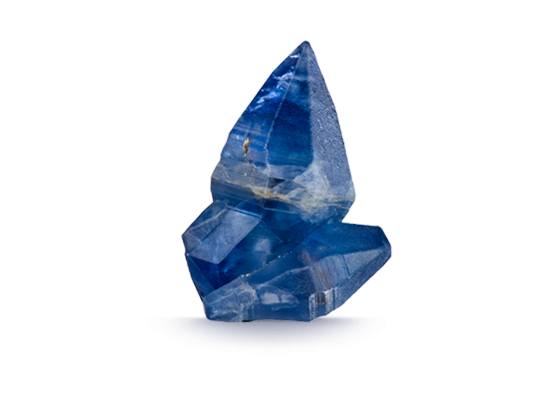OVERVIEW
Besides blue sapphire and ruby, the corundum family also includes so-called “fancy sapphires.” They come in violet, green, yellow, orange, pink, purple, and intermediate hues. Some stones exhibit the phenomenon known as color change, most often going from blue in daylight or fluorescent lighting to purple under incandescent light. Sapphires can even be gray, black, or brown.
Blue sapphire belongs to the mineral species corundum. It can be a pure blue but ranges from greenish blue to violetish blue. The name “sapphire” can also apply to any corundum that’s not red and doesn’t qualify as ruby, another corundum variety.
Besides blue sapphire and ruby, the corundum family also includes so-called “fancy sapphires.” They come in violet, green, yellow, orange, pink, purple, and intermediate hues. There are also “parti-colored” sapphires that show combinations of different colors. Some stones exhibit the phenomenon known as color change, most often going from blue in daylight or fluorescent lighting to purple under incandescent light. Sapphires can even be gray, black, or brown.
Fancy sapphires are generally less available than blue ones, and some colors are scarce, especially in very small or very large sizes. Still, fancy sapphires create a rainbow of options for people who like the romance associated with this gem, but who also want something out of the ordinary.
- Mineral: Corundum
- Chemistry: Al2O3
- Color: Every color but red
- Refractive index: 1.762 to 1.770
- Birefringence: 0.008 to 0.010
- Specific gravity: 4.00
- Mohs Hardness: 9
WHERE IS IT FOUND ?
Kashmir, Myanmar (formerly Burma) and Sri Lanka are three historically important sources for the September birthstone. Significant quantities of the September birthstone have also been found in Australia, Thailand, Cambodia, Madagascar and the United States (Montana), among other countries in Asia and Africa.
Sapphires were discovered in Kashmir around 1881 when a landslide high in the Himalayas exposed a large pocket of velvety “cornflower” blue crystals. As the spectacular sapphires began to appear farther south, the Maharaja of Kashmir – and his army – took control of the new locality. From 1882 to 1887, thousands of large, beautiful crystals were recovered. The stones faceted from these crystals established Kashmir sapphire’s reputation as one of the world’s most coveted gems. Production has been sporadic since then, but auction houses occasionally sell fine pieces of Kashmir sapphire jewelry.
CARE & CLEANING
The September birthstone is relatively hard, ranking 9 on the Mohs scale. It has excellent toughness and no cleavage, which is a tendency to break when struck. This makes it a great choice for rings and other mountings subject to daily wear.
Note, though, that sapphires are often treated to improve their color or clarity. Heat treatment is common – and the results permanent – so it is well accepted in the trade. Less common treatments such as lattice diffusion, fracture filling and dyeing may require special care. In some cases, the color induced by lattice diffusion is so shallow it could be removed if the stone was chipped or had to be recut. Fracture-filled and dyed sapphires can be damaged by even mild acids like lemon juice. Before you buy a sapphire, always ask if it is treated and by what method.
Warm, soapy water is always a safe choice for cleaning the September birthstone. Ultrasonic and steam cleaners are usually safe for untreated, heat-treated and lattice diffusion–treated stones. Fracture-filled or dyed material should only be cleaned with a damp cloth.
BIRTHSTONE
Sapphire is the birthstone for September and the gem of the 5th and 45th anniversaries.
HISTORY
Traditionally, sapphire symbolizes nobility, truth, sincerity, and faithfulness. It has decorated the robes of royalty and clergy members for centuries. Its extraordinary color is the standard against which other blue gems—from topaz to tanzanite—are measured.
For centuries, sapphire has been associated with royalty and romance. The association was reinforced in 1981, when Britain’s Prince Charles gave a blue sapphire engagement ring to Lady Diana Spencer. Until her death in 1997, Princess Di, as she was known, charmed and captivated the world. Her sapphire ring helped link modern events with history and fairy tales.
In ancient Greece and Rome, kings and queens were convinced that blue sapphires protected their owners from envy and harm. During the Middle Ages, the clergy wore blue sapphires to symbolize Heaven, and ordinary folks thought the gem attracted heavenly blessings. In other times and places, people instilled sapphires with the power to guard chastity, make peace between enemies, influence spirits, and reveal the secrets of oracles.
In folklore, history, art, and consumer awareness, sapphire has always been associated with the color blue. Its name comes from the Greek word sappheiros, which probably referred to lapis lazuli. Most jewelry customers think all sapphires are blue, and when gem and jewelry professionals use the word “sapphire” alone, they normally mean “blue sapphire.”
A special orangy pink sapphire color is called padparadscha, which means “lotus flower” in Sinhalese, the language spoken in Sri Lanka. Stones from Sri Lanka were initially the only ones labeled with this marketable name. There’s no telling how many padparadschas have been sifted from Sri Lankan river gravel throughout history. Sri Lankans have a special affection for the color that’s traditionally been linked with their country.
Source of Content : www.gia.edu


